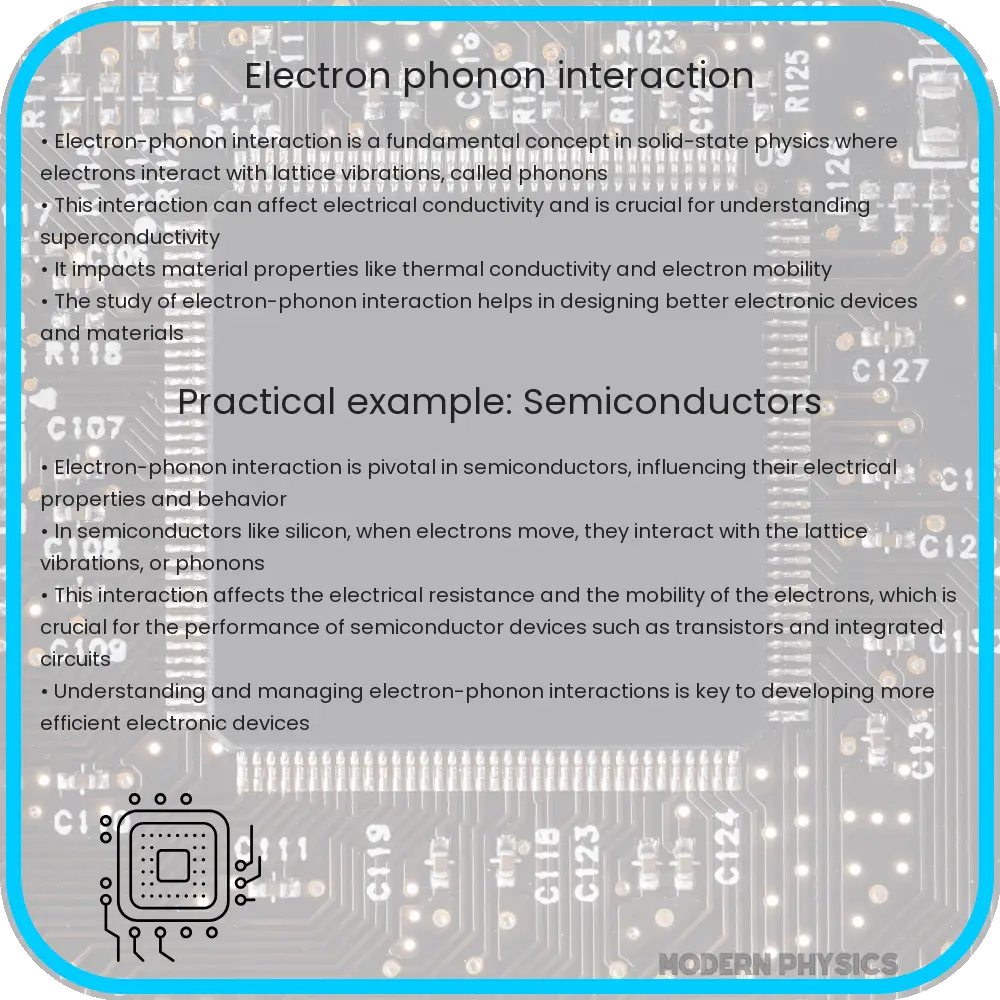Explore the fundamentals of electron-phonon interactions, their effects on materials’ properties, and applications in technology and superconductivity.

Understanding Electron-Phonon Interaction
Electron-phonon interaction is a fundamental concept in the field of condensed matter physics, playing a crucial role in determining the electrical, thermal, and optical properties of materials. This interaction between electrons and phonons, which are quanta of lattice vibrations, is pivotal for understanding various phenomena in solid-state physics.
Basics of Electron-Phonon Interaction
At the heart of electron-phonon interaction is the coupling between the movement of electrons and the vibrational modes of a crystal lattice. Electrons moving through a solid can scatter off lattice vibrations, leading to an exchange of energy and momentum. This scattering process is influenced by the material’s crystal structure, temperature, and electron energy levels.
Effects of Electron-Phonon Interaction
- Electrical Conductivity: Electron-phonon interactions can significantly affect a material’s electrical conductivity. At low temperatures, lattice vibrations are reduced, leading to decreased electron scattering and higher conductivity. Conversely, at higher temperatures, increased lattice vibrations enhance scattering, reducing conductivity.
- Superconductivity: The Cooper pairing of electrons, essential for superconductivity, is mediated by electron-phonon interactions. In this phenomenon, two electrons with opposite spins and momenta form a bound state via the exchange of phonons, leading to resistance-free current flow below a critical temperature.
- Thermal Properties: Electron-phonon interactions also influence thermal conductivity and heat capacity. The ability of electrons to scatter off phonons contributes to the transfer of thermal energy through a material.
Applications of Electron-Phonon Interactions
The understanding of electron-phonon interactions is crucial for the development of new materials and technologies. Applications range from traditional semiconductors, where controlling electron scattering is vital for device performance, to novel superconductors, where manipulating electron-phonon coupling can enhance superconducting temperatures. Additionally, thermoelectric materials, which convert heat into electrical energy, rely on optimizing electron-phonon interactions to improve efficiency.
In conclusion, electron-phonon interactions are at the core of many fundamental and applied aspects of material science. By influencing electrical, thermal, and optical properties, these interactions are key to advancing current technologies and developing new ones.
Advanced Insights into Electron-Phonon Interaction
The intricate dance between electrons and phonons goes beyond basic conductivity and superconductivity. It extends to the realms of optical properties and even to the emerging field of quantum computing. Materials with strong electron-phonon coupling can exhibit unique optical phenomena, such as Raman scattering, where incident light is inelastically scattered, providing a fingerprint of the material’s phonon modes.
Quantum Computing and Electron-Phonon Interaction
In the burgeoning field of quantum computing, understanding electron-phonon interactions is critical. Quantum bits, or qubits, can be affected by decoherence caused by interactions with phonons, leading to errors in quantum computation. Engineering materials that minimize these interactions, or developing error-correcting codes that can mitigate their effects, is essential for the advancement of reliable quantum computers.
Challenges and Future Directions
Despite its fundamental role in condensed matter physics, fully understanding and controlling electron-phonon interactions remains a challenge. Advances in computational methods, such as density functional theory (DFT), have allowed scientists to predict electron-phonon coupling strength and its effects on material properties with increasing accuracy. Experimental techniques, including angle-resolved photoemission spectroscopy (ARPES) and inelastic neutron scattering, provide direct insights into these interactions at the atomic level.
The future of electron-phonon interaction research lies in the synthesis of new materials with tailored properties. By manipulating the strength and nature of these interactions, it’s possible to design materials with optimized electronic, thermal, and optical characteristics for specific applications, from high-temperature superconductors to efficient thermoelectric devices.
Conclusion
Electron-phonon interactions are a cornerstone of modern condensed matter physics, underpinning the behavior of materials and the development of innovative technologies. The interplay between electrons and lattice vibrations affects everything from electrical conductivity and superconductivity to thermal properties and quantum computing. As research in this area progresses, leveraging advanced computational and experimental methods, we can anticipate the emergence of new materials and devices with unprecedented functionalities. The continuous exploration of electron-phonon interactions not only deepens our understanding of the quantum world but also paves the way for the next generation of technological advancements.
